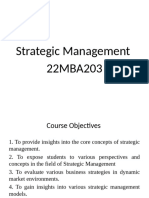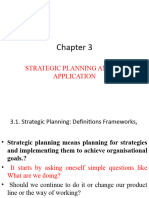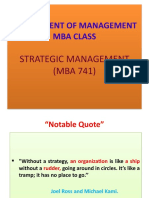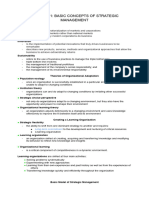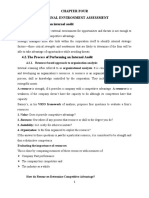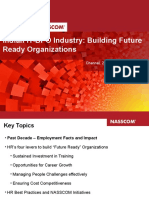0 ratings0% found this document useful (0 votes)
22 viewsUnit 2 - Organisational Strategy
Unit 2 - Organisational Strategy
Uploaded by
Muhammad IqbalThe document discusses organizational strategy, including the meaning of corporate strategy and its characteristics. It also provides examples of strategic decisions in construction and compares reactive and proactive strategic approaches. Finally, it outlines the seven stages of developing a business strategy, including strategic analysis, formulation, evaluation, choice, implementation, and control.
Copyright:
© All Rights Reserved
Available Formats
Download as PDF, TXT or read online from Scribd
Unit 2 - Organisational Strategy
Unit 2 - Organisational Strategy
Uploaded by
Muhammad Iqbal0 ratings0% found this document useful (0 votes)
22 views20 pagesThe document discusses organizational strategy, including the meaning of corporate strategy and its characteristics. It also provides examples of strategic decisions in construction and compares reactive and proactive strategic approaches. Finally, it outlines the seven stages of developing a business strategy, including strategic analysis, formulation, evaluation, choice, implementation, and control.
Original Description:
- Organisational Strategy(1)
Original Title
Unit 2 - Organisational Strategy(1)
Copyright
© © All Rights Reserved
Available Formats
PDF, TXT or read online from Scribd
Share this document
Did you find this document useful?
Is this content inappropriate?
The document discusses organizational strategy, including the meaning of corporate strategy and its characteristics. It also provides examples of strategic decisions in construction and compares reactive and proactive strategic approaches. Finally, it outlines the seven stages of developing a business strategy, including strategic analysis, formulation, evaluation, choice, implementation, and control.
Copyright:
© All Rights Reserved
Available Formats
Download as PDF, TXT or read online from Scribd
Download as pdf or txt
0 ratings0% found this document useful (0 votes)
22 views20 pagesUnit 2 - Organisational Strategy
Unit 2 - Organisational Strategy
Uploaded by
Muhammad IqbalThe document discusses organizational strategy, including the meaning of corporate strategy and its characteristics. It also provides examples of strategic decisions in construction and compares reactive and proactive strategic approaches. Finally, it outlines the seven stages of developing a business strategy, including strategic analysis, formulation, evaluation, choice, implementation, and control.
Copyright:
© All Rights Reserved
Available Formats
Download as PDF, TXT or read online from Scribd
Download as pdf or txt
You are on page 1of 20
Organisational Strategy
Taha Elhag – Turker Bayrak – Satesh Namasivayam
School of Energy, Geoscience, Infrastructure & Society
Heriot-Watt University
Meaning of Corporate Strategy
• Corporate strategy is the pattern of major
objectives, purposes or goals and essential
policies or plans for achieving those goals.
• Corporate strategy needs to answer the
following questions:
– What is the organisation best at?
– Where does the organisation stand now in relation to the
external environment
– Where should the organisation be in a few years time?
Characteristics of Strategy
• Strategy is about long term;
• Strategy aims at gaining advantage;
• Strategy concerns the scope of an organisation’s activities;
• Strategy aims at matching organisation’s activities to the
environment;
• Strategy is about maximise the available resources;
• Strategy may require major resource changes;
• Strategy reflects the attitudes and beliefs of senior
managers. It is influenced by environmental forces.
Examples of Strategic Decisions in
Construction
• Diversification of building types
• Expanding or shrinking the market, by type of
client or/and location
• Differentiation of building product (uniqueness)
• Producing better value-for-money buildings
• Ownership
• Merger or company takeover
• Partnership
• Contracts bidding.
Reactor (Reactive) vs Planned
(Proactive) Approaches
• Reactor (Reactive) Approach is informal
and unsystematic. It is often adopted by
small firms, who ‘wait and see’ and
respond to environmental changes.
• Planned (Proactive) Approach is formal
and systematic. It is often adopted by
large and sophisticated firms, who look
ahead for opportunities and threats.
Advantages of Reactor (Reactive)
Approach
• Save executive time, cost and talent by
not engaging in formal planned strategy;
• Opportunities will not be restricted to
those included in the strategic plan;
• May gain by delaying decisions when
fuller information becomes available.
Advantages of Planned (Proactive)
Approach
• Pay attention to important issues • Avoid the need for crisis
• Examine own strengths and management
weaknesses • Plan changes and minimise
• Identify opportunities early disruption to existing operation
• Consider risks as well as • Focus effort of everyone and
opportunities enhance internal harmony
• Study competitors • Reassure and motivate staff
• Anticipate changes in • Promote strategic thinking
marketplace and environment amongst the senior decision
makers
Seven Stages of Developing a
Business Strategy
1. Strategic analysis
2. Strategy formulation
3. Evaluation of alternative strategies
4. Strategic choice
5. Action plan
6. Strategy implementation
7. Strategic control and feedback
1. Strategic Analysis
• Analysis of environmental forces
– Use the PEST framework to examine political,
economical, social and technological forces to identify
opportunities and threats
• Organisational goal and objectives
– Goal is a statement of general intention; objectives
(economic and non-economic) are more specific targets
to achieve in order to realise the overall goal.
• Organisational appraisal
– Analyse the market and own strengths and weaknesses,
using the SWOT technique
1. Strategic Analysis - External
Forces
• Political
• Economical
• Social
• Technological
1. Strategic Analysis – SMART
Objectives
• When setting organisational objectives,
follow the SMART principle:
– Specific
– Measurable
– Achievable
– Realistic
– Timebound
1. Strategic Analysis – SWOT
Technique
Positive Negative
Internal Strengths: positive aspects or Weaknesses: negative aspects or
distinctive competencies, which deficiencies in current
provide market advantage competencies or resources
External Opportunities: favourable Threats: unfavourable external
conditions with changes in conditions that endanger operation
external environment and effectiveness
2. Strategy Formulation
• On the basis of Stage 1 – Strategic Analysis,
clear objectives are decided. Then different
alternative plans may be proposed to achieve
these objectives.
• These plans should answer a number of
questions:
– What should the organisation do?
– Where?
– How? and
– When?
3. Evaluation of Alternative
Strategies
• The alternative plans, defined in Stage 2, are evaluated
using cost/benefit analysis:
– Costs
• Financing
• Human resources
• Administrative resources
– Benefits
• Profit
• Growth
• Risk
• A range of tools and techniques are available for this task,
such as decision trees, sensitivity analysis, and simulation
modelling.
4. Strategic Choice
• In deciding between strategic options, executive
management needs to ask a series of questions:
– Which option is the optimum choice according to
SWOT?
– Can it be put into practice?
– Can the required finance be raised?
– Can required staff be recruited or trained?
– Is it acceptable to the stakeholders?
• The choice between different options may not be
clear-cut.
5. Action Plan
• An action plan provides a blueprint for
implementing the chosen strategy;
• An action plan should include:
– The activities involved
– Allocation of financing
– Allocation of human resources
– Allocation of administrative resources
– The sequence and timing of each activity
• Action plan may include both long time plan and
short term plan
6. Strategy Implementation - Tasks
• Make the right things happen at the right
time, as planned:
– Assembling resources, as planned
– Structuring work relationships
– Integrating and controlling people and
activities
6. Strategy Implementation -
Checklist
• Successful implementation requires answers to
the following questions:
– Who is responsible for carrying out the strategy?
– What are the key activities that need to be carried
out?
– Who should do what and when?
– Is there a need for new recruitment?
– What type of management information system is
needed to monitor process?
– How will the implementation process work?
7. Strategic Control and Feedback
• This is the phase to monitor progress; take corrective
action to ensure successful implementation of
strategic plan. It includes the following six steps:
1. establishment of standards of performance
2. measurement of performance against performance
standards
3. diagnosis of deviations from standards
4. initiation of corrective action
5. feedback from internal and external environments
6. continuation of performance monitoring.
Learning Outcomes
• Students should understand the importance of organisational
strategy;
• Students should know the main external factors that have an
influence on an organisational strategy;
• Students should be able to compare reactor approach and planned
approach to organisational strategy;
• Students should know the main stages of the strategy development
process and the main tasks at each stage;
• Students should be familiar with the SWOT analysis technique.
You might also like
- Full Download (Ebook PDF) Joining Together: Group Theory and Group Skills 12th Edition PDFDocument51 pagesFull Download (Ebook PDF) Joining Together: Group Theory and Group Skills 12th Edition PDFkardoldhaana100% (5)
- Hull Smart City OS ProjectDocument27 pagesHull Smart City OS Projectabdullahkahlon258No ratings yet
- CMQ-OE Exam - Free Actual Q&As, Page 3 - ExamTopicsDocument32 pagesCMQ-OE Exam - Free Actual Q&As, Page 3 - ExamTopicsmd_rehan_2100% (1)
- Unit 2 Planning and Decision MakingDocument61 pagesUnit 2 Planning and Decision MakingAnkit Patidar100% (1)
- Stratman C1Document6 pagesStratman C1Marian R SilaoNo ratings yet
- Chapter 3 TQMDocument22 pagesChapter 3 TQMSadiya abdullahNo ratings yet
- Chapter 1 Strategic Management ProcessDocument30 pagesChapter 1 Strategic Management ProcessNonhlanhla MhlongoNo ratings yet
- Strategic Management Process: AnDocument26 pagesStrategic Management Process: AnKey OnNo ratings yet
- Unit - 4Document161 pagesUnit - 4Shashi RazputNo ratings yet
- SM Ch-1Document89 pagesSM Ch-1Pavlo Andre AbiyNo ratings yet
- Chapter Three: Planning FunctionDocument134 pagesChapter Three: Planning Functionሻሎም ሃፒ ታዲNo ratings yet
- Strategy Analysis & Choice Implementing Strategies: Management IssuesDocument30 pagesStrategy Analysis & Choice Implementing Strategies: Management IssuesBorey KimyeatNo ratings yet
- CH 1 Strategic MGMT OveviewDocument28 pagesCH 1 Strategic MGMT Oveviewtemesgen yohannesNo ratings yet
- 4 - Planning and Strategic ManagementDocument35 pages4 - Planning and Strategic ManagementEmmanuel DaguroNo ratings yet
- 6 StrategiesDocument45 pages6 StrategiesKeerthi KumarNo ratings yet
- Strategic MGMTDocument44 pagesStrategic MGMTMustafa SaifeeNo ratings yet
- I. IntroductionDocument24 pagesI. IntroductionMico UgaldeNo ratings yet
- SM 8 - Strategy EvaluationDocument26 pagesSM 8 - Strategy EvaluationAmit Sethi100% (1)
- Chapter 5 Foundations of PlanningDocument31 pagesChapter 5 Foundations of PlanningNiz Ismail0% (1)
- SM Module-1Document109 pagesSM Module-1sudheesh ksNo ratings yet
- Strategic Management - 2024Document35 pagesStrategic Management - 2024aakhi0887No ratings yet
- Strategic MNM CHAP 1Document11 pagesStrategic MNM CHAP 1王巧慧No ratings yet
- Planing Chapter 3Document34 pagesPlaning Chapter 3HundeNo ratings yet
- Additional Notes 1 - A Roadmap To Organizational SuccessDocument13 pagesAdditional Notes 1 - A Roadmap To Organizational Successyopena1951No ratings yet
- unit-4-BIM-1Document48 pagesunit-4-BIM-1bibeksapkota545No ratings yet
- Module 3 - Planning and Strategic Management1Document56 pagesModule 3 - Planning and Strategic Management1Joel MendozaNo ratings yet
- Chapter Seven: Basic Elements of Planning and Decision MakingDocument42 pagesChapter Seven: Basic Elements of Planning and Decision MakingPereira JoelNo ratings yet
- TLIP5011A Presentation 1Document17 pagesTLIP5011A Presentation 1email4johnnNo ratings yet
- Module 4 SMDocument19 pagesModule 4 SMANJALINo ratings yet
- Strategic MGT U-1Document26 pagesStrategic MGT U-1Mitiku ShewaNo ratings yet
- Lesson 1-StramaaaDocument33 pagesLesson 1-Stramaaaishinoya keishiNo ratings yet
- Governance (Bitmedi)Document19 pagesGovernance (Bitmedi)tedxitu2022No ratings yet
- BBa 3yr Unit 5Document47 pagesBBa 3yr Unit 5sai rocksNo ratings yet
- Q2Planning Foundation of StrategyDocument27 pagesQ2Planning Foundation of StrategyHazeL Joy DegulacionNo ratings yet
- Course Orientation: Business PolicyDocument11 pagesCourse Orientation: Business PolicyPia Angela ElemosNo ratings yet
- ABCDE Strategic Plan ModelDocument31 pagesABCDE Strategic Plan ModelMbah Taufiq88% (8)
- Strategic Management - More Lecture Notes - Dr. A. KaulDocument16 pagesStrategic Management - More Lecture Notes - Dr. A. KaulShivani JoshiNo ratings yet
- Objective 3 Continuation - Theatre Administrative ServicesDocument20 pagesObjective 3 Continuation - Theatre Administrative ServicestallagybrandconceptsNo ratings yet
- 3 Strategic Management ModelDocument32 pages3 Strategic Management ModelSiddhant AggarwalNo ratings yet
- Daniyal AssignmentDocument9 pagesDaniyal AssignmentWazeeer AhmadNo ratings yet
- Strategic ManagementDocument82 pagesStrategic ManagementcreativejoburgNo ratings yet
- SjycDocument52 pagesSjycsonam gargNo ratings yet
- Strategic Management Chapter 4Document48 pagesStrategic Management Chapter 4kenetiNo ratings yet
- The Strategy PDFDocument5 pagesThe Strategy PDFTRICIA JEAN NICOLE MENDOZANo ratings yet
- 4 - Planning and Strategic Management - NewDocument47 pages4 - Planning and Strategic Management - NewKamil Ubungen Delos ReyesNo ratings yet
- The SocietyDocument33 pagesThe SocietyJonrei NatividadNo ratings yet
- Of Effective StrategiesDocument2 pagesOf Effective Strategiesanisha jaiswalNo ratings yet
- Chapter 2 Concept of StrategyDocument20 pagesChapter 2 Concept of Strategyprasad guthiNo ratings yet
- Chapter 1 - EditedDocument33 pagesChapter 1 - Editedjessemackett777No ratings yet
- 2 PlanningDocument14 pages2 Planninghari_krishnan_27No ratings yet
- MGT162 C2Document43 pagesMGT162 C2joebloggs1888No ratings yet
- Strategy Development and Deployment ProcessDocument16 pagesStrategy Development and Deployment ProcessUnit2quality HorizonchutesNo ratings yet
- 5 - PlanningDocument34 pages5 - PlanningHansoloNo ratings yet
- Strategic ImplementationDocument20 pagesStrategic Implementationraosahab121004No ratings yet
- Unit2 - : PlanningDocument64 pagesUnit2 - : Planningpho tosNo ratings yet
- Strategic Thinking and PlanningDocument20 pagesStrategic Thinking and PlanningAsra AkramNo ratings yet
- Essentials of Planning and Management by Objectives (MBO)Document30 pagesEssentials of Planning and Management by Objectives (MBO)Adil HassanNo ratings yet
- Unit 2Document58 pagesUnit 2niyati dixitNo ratings yet
- STRAMA ReviewerDocument11 pagesSTRAMA Reviewernaguirre950No ratings yet
- unit 4Document25 pagesunit 4narayansapkota2027No ratings yet
- Strategic SC 1Document63 pagesStrategic SC 1abbasgudisaNo ratings yet
- Unit4 PlanningDocument31 pagesUnit4 PlanningManseez KaurNo ratings yet
- Letters of IntentDocument5 pagesLetters of IntentMuhammad IqbalNo ratings yet
- When Is An Offer Actually Made?: Carlill V Carbolic Smoke Ball Co (1893) 1 QB 256Document6 pagesWhen Is An Offer Actually Made?: Carlill V Carbolic Smoke Ball Co (1893) 1 QB 256Muhammad IqbalNo ratings yet
- Worked Pre-Tender Example: PreliminariesDocument6 pagesWorked Pre-Tender Example: PreliminariesMuhammad IqbalNo ratings yet
- Lesson 4 Humans at Jebel FayaDocument2 pagesLesson 4 Humans at Jebel FayaMuhammad IqbalNo ratings yet
- Evidence of Oneness of Allah: (Imran: 2:) There Is No God But He, The Living The Self Subsisting'Document1 pageEvidence of Oneness of Allah: (Imran: 2:) There Is No God But He, The Living The Self Subsisting'Muhammad IqbalNo ratings yet
- Academic Writing HWDocument70 pagesAcademic Writing HWMuhammad IqbalNo ratings yet
- ProviderList - Sun Jan 21 08-43-47 GMT 2018Document3 pagesProviderList - Sun Jan 21 08-43-47 GMT 2018Muhammad IqbalNo ratings yet
- Global Direct Settlement NetworkDocument2 pagesGlobal Direct Settlement NetworkMuhammad IqbalNo ratings yet
- Grade 1 12 Exam Portion Islamic Non ArabDocument8 pagesGrade 1 12 Exam Portion Islamic Non ArabMuhammad IqbalNo ratings yet
- ProviderList - Sun Jan 21 09-19-21 GMT 2018Document4 pagesProviderList - Sun Jan 21 09-19-21 GMT 2018Muhammad IqbalNo ratings yet
- The Best Book To Learn Forex TradingDocument7 pagesThe Best Book To Learn Forex TradingMuhammad Iqbal50% (2)
- ColoringDocument1 pageColoringMuhammad Iqbal100% (1)
- Kids StoriesDocument8 pagesKids StoriesMuhammad IqbalNo ratings yet
- Construction Claim AnalysisDocument7 pagesConstruction Claim Analysissankuj5354100% (2)
- Human FactorsDocument234 pagesHuman FactorsAbdelsamie Ali100% (5)
- Project Excution and Control FourDocument40 pagesProject Excution and Control FourMohammad AbdullahNo ratings yet
- Educational Management-Reaction PaperDocument3 pagesEducational Management-Reaction PaperMaria100% (3)
- Fdster 1gsgDocument28 pagesFdster 1gsgUnknown_unknown_unknownNo ratings yet
- APICS CSCP2014 Learning System SmartStudy ToolDocument3 pagesAPICS CSCP2014 Learning System SmartStudy ToolpraveenjuturNo ratings yet
- The Role of Communication in Enhancing Work EffectDocument9 pagesThe Role of Communication in Enhancing Work EffectHamza NazirNo ratings yet
- Group Disscusion Part 111Document14 pagesGroup Disscusion Part 111Hemanth JNo ratings yet
- 4.1. The Nature of An Internal Audit: Chapter Four Internal Environment AssessmentDocument10 pages4.1. The Nature of An Internal Audit: Chapter Four Internal Environment AssessmentwubeNo ratings yet
- Roles & Duties of CIODocument13 pagesRoles & Duties of CIOXiane BaltimoreNo ratings yet
- BBA POM 1st SemDocument12 pagesBBA POM 1st Semvarun bhaskarNo ratings yet
- NASSCOM HR Summit Presentation FinalDocument31 pagesNASSCOM HR Summit Presentation FinalMusadaq HanandiNo ratings yet
- Case 1Document3 pagesCase 1SHILPA GOPINATHANNo ratings yet
- Bryce Anderson: Bachelor of Science in Business AdministrationDocument1 pageBryce Anderson: Bachelor of Science in Business AdministrationBryce AndersonNo ratings yet
- Talent Management: Concept and Approaches Ses 1Document8 pagesTalent Management: Concept and Approaches Ses 1Nishan ShettyNo ratings yet
- QF 5 6-Management Review Agenda and MinutesDocument4 pagesQF 5 6-Management Review Agenda and MinutesRafik BizerteNo ratings yet
- Reason of Leadership FailureDocument4 pagesReason of Leadership FailureandreaNo ratings yet
- Complete Guide To Ethics ManagementDocument38 pagesComplete Guide To Ethics ManagementAnuj NaikNo ratings yet
- Lesson 5.1Document13 pagesLesson 5.1Christian MendozaNo ratings yet
- CSC 12 Q3 0103 - PS - Community Dynamics and Actions 1Document43 pagesCSC 12 Q3 0103 - PS - Community Dynamics and Actions 1kennethguillermo93No ratings yet
- (Ebook PDF) Essentials of Contemporary Management 5th Canadian Edition All Chapter Instant DownloadDocument51 pages(Ebook PDF) Essentials of Contemporary Management 5th Canadian Edition All Chapter Instant Downloadswessimatita100% (5)
- Bureaucratic Leadership Style and Its CharacteristicsDocument8 pagesBureaucratic Leadership Style and Its CharacteristicsIrfan A. FaridiNo ratings yet
- IBS Business SchoolDocument21 pagesIBS Business Schooltajju_121No ratings yet
- International Business EtiquettaDocument14 pagesInternational Business EtiquettaDOWLA KHANNo ratings yet
- Chapter 7 - GOOD GOVERNANCEDocument13 pagesChapter 7 - GOOD GOVERNANCEnurul huda sayed abu bakarNo ratings yet
- Inchara Murthy Final ProjectDocument56 pagesInchara Murthy Final ProjectVenki GajaNo ratings yet
- Identifying and Empowering Instructional LeadersDocument6 pagesIdentifying and Empowering Instructional Leadersapi-593954363No ratings yet
- 2 Project Diversity Managment in Workplace PDFDocument22 pages2 Project Diversity Managment in Workplace PDFFisehaNo ratings yet





















